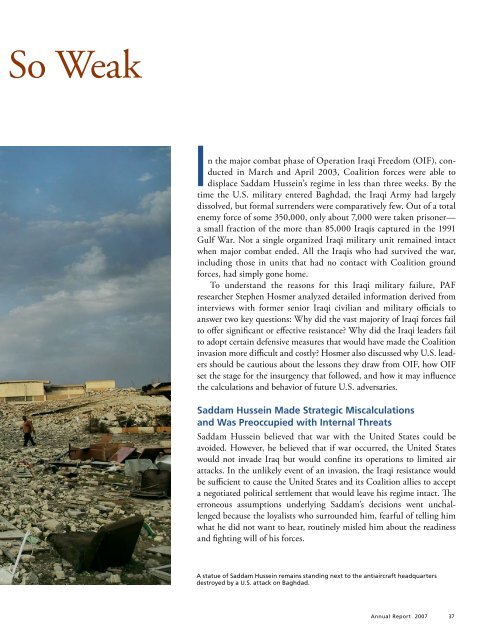RAND Project AIR FORCE Annual Report 2007 - RAND Corporation
RAND Project AIR FORCE Annual Report 2007 - RAND Corporation
RAND Project AIR FORCE Annual Report 2007 - RAND Corporation
Create successful ePaper yourself
Turn your PDF publications into a flip-book with our unique Google optimized e-Paper software.
So WeakIn the major combat phase of Operation Iraqi Freedom (OIF), conductedin March and April 2003, Coalition forces were able todisplace Saddam Hussein’s regime in less than three weeks. By thetime the U.S. military entered Baghdad, the Iraqi Army had largelydissolved, but formal surrenders were comparatively few. Out of a totalenemy force of some 350,000, only about 7,000 were taken prisoner—a small fraction of the more than 85,000 Iraqis captured in the 1991Gulf War. Not a single organized Iraqi military unit remained intactwhen major combat ended. All the Iraqis who had survived the war,including those in units that had no contact with Coalition groundforces, had simply gone home.To understand the reasons for this Iraqi military failure, PAFresearcher Stephen Hosmer analyzed detailed information derived frominterviews with former senior Iraqi civilian and military officials toanswer two key questions: Why did the vast majority of Iraqi forces failto offer significant or effective resistance? Why did the Iraqi leaders failto adopt certain defensive measures that would have made the Coalitioninvasion more difficult and costly? Hosmer also discussed why U.S. leadersshould be cautious about the lessons they draw from OIF, how OIFset the stage for the insurgency that followed, and how it may influencethe calculations and behavior of future U.S. adversaries.Saddam Hussein Made Strategic Miscalculationsand Was Preoccupied with Internal ThreatsSaddam Hussein believed that war with the United States could beavoided. However, he believed that if war occurred, the United Stateswould not invade Iraq but would confine its operations to limited airattacks. In the unlikely event of an invasion, the Iraqi resistance wouldbe sufficient to cause the United States and its Coalition allies to accepta negotiated political settlement that would leave his regime intact. Theerroneous assumptions underlying Saddam’s decisions went unchallengedbecause the loyalists who surrounded him, fearful of telling himwhat he did not want to hear, routinely misled him about the readinessand fighting will of his forces.A statue of Saddam Hussein remains standing next to the antiaircraft headquartersdestroyed by a U.S. attack on Baghdad.<strong>Annual</strong> <strong>Report</strong> <strong>2007</strong> 37
















